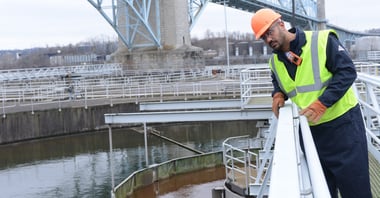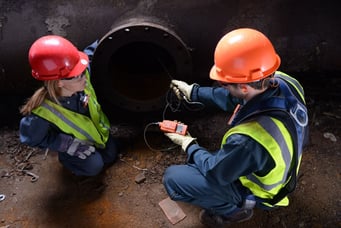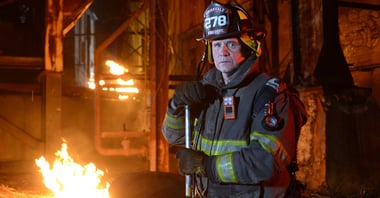You see water treatment plants and drive past them all the time. Every community has one. Chances are that a close neighbor, one of your best friends, or even a member of your family may work in a wastewater facility. When low pressure sets in or the wind blows in the right direction, the stench is horrific. But the smell is only a hint to the abundant hazards that you might encounter when working at a wastewater treatment plant.
Some of the basic hazards in wastewater treatment plants can include slips, trips, and falls. There is also the danger of atmospheric hazards and harmful gases, which can increase the risk of other threats. The possibility of severe trauma or even drowning from falling into a confined space—such as a wet well, recirculation pit, or a clarifier tank—means the risks associated with working in a wastewater facility may by higher than we recognize or care to admit.
That’s why it’s so important to be aware of the potential dangers in wastewater facilities and provide your workers with the equipment and training they need to get home safely at the end of each day.
Gas Hazards in Wastewater Treatment Plants
The main gases of concern in wastewater treatment plants are methane, hydrogen sulfide, and oxygen (or lack of oxygen, also known as oxygen deficiency). Hydrogen sulfide and methane are the byproducts of the decomposition of organic materials that exist in the waste flows feeding the plant. The buildup of these gases may displace oxygen—causing it to reach unsafe levels—or in some cases, cause an explosion when coupled with an ignition source.
These are the primary culprits in water facilities, but the number of gas hazards present may be too numerous to name. Beyond the big three gas hazards are the dangers that exist from purifying chemicals used to decontaminate waste and effluent water, including ammonia, chlorine, chlorine dioxide, or ozone.
In addition to water treatment chemicals, workers should be cautious of the potential presence of toxic or explosive gases from the chemicals spilled or dumped into the waste system from the industrial base in the community.
Given the range of dangers from gas hazards alone, what can you do to prepare your workers for the safety concerns at a water treatment plant?
Safety Precautions in Wastewater Facilities
.webp?width=456&height=318&name=watertreatment-1%20(1).webp) Elimination of these gas hazards is virtually impossible, so permanent workers and contractors must depend on reliable gas detection equipment to protect them. Although there is not one “silver bullet” gas monitor that will protect every worker in every situation, a multi-gas monitor is a good place to start.
Elimination of these gas hazards is virtually impossible, so permanent workers and contractors must depend on reliable gas detection equipment to protect them. Although there is not one “silver bullet” gas monitor that will protect every worker in every situation, a multi-gas monitor is a good place to start.
A standard four-gas monitor equipped with the proper sensors provides protection from the primary methane, hydrogen sulfide, and oxygen hazards. The fourth gas sensor, usually carbon monoxide, can often be replaced with an ammonia or chlorine sensor to add protection against one of the more prevalent chemical hazards unique to your treatment plant.
Upgrading from a four-gas monitor to a five-gas monitor, or even six-gas monitor, may allow you to advance the level of detection and protect yourself from even more of the potential chemical hazards.
Unfortunately, protecting workers from the dangers of gas hazards is not as easy as simply handing them a gas detector and sending them out the door. If workers do not use their monitors properly, do not understand how their monitors work, or do not know how to react to the readings, gas detection devices will not be very effective.
Effectively Using Gas Monitors in a Water Treatment Plant
The first step is that workers must know how to turn the monitor on and verify that the gas detector they carry can detect every hazard they may encounter in the wastewater plant. This is accomplished by performing a bump test. Bump tests expose a gas monitor to a concentration of each gas it is designed to detect and verifies that the sensor responds and the monitor alarms properly.
The simple truth is that the only way to be certain that a gas monitor will detect the gases that it’s designed to detect is to test it with gas. Bump testing may sound like a complicated procedure, but it’s as simple as placing the monitor on a test stand or docking station equipped with the appropriate gases and having the test run automatically. This should be done each and every time your workers pick up a gas monitor for their shift.
The more hazards that a monitor is intended to protect against, the more crucial it is to understand how the sensors in the monitor interact. This is because certain sensor combinations can result in cross-interference, impacting the accuracy of a gas monitor’s readings and putting the user in danger of exposure.
For instance, a user with a gas monitor with both hydrogen sulfide (H2S) and chlorine sensors installed must understand that the presence of H2S in the atmosphere may negatively affect the reading from the chlorine sensor, masking the presence of a dangerous level of chlorine gas in the atmosphere.
Users should refer to the instrument manufacturers for information on the cross-interference levels and interactions between sensors.
Responding to Alarms
In addition to understanding the sensors themselves, your workers must understand how to respond when a gas monitor does detect a hazard and goes into alarm. Otherwise, the equipment can’t effectively protect them from danger.
Often, when a gas detector alarms, an untrained user may panic and do something that creates further danger, or they may simply ignore the situation because they don’t know what to do next.
Some gas monitors provide alarm action messages that display text instructions, guiding workers toward the appropriate actions when the monitor alarms. Telling workers to “WEAR A RESPIRATOR” or “EVACUATE” when their gas detector alarms reinforces their training and safety procedures in a high-stress situation.
Realistically, there may be instances when a gas monitor is simply not capable of providing the necessary protection quickly enough, and a worker may be overcome by a gas hazard or incapacitated in some other way. It is important that workers use a gas monitor that can alert others when they’re in danger and need help.
Some gas monitors are equipped with a panic button that lets workers signal others when they need help with the press of a button. Another useful feature in a gas monitor is one that uses motion detection to sound a “man down” alarm when a worker has been motionless for a period of time. More advanced gas detectors trigger alarms on peers’ gas monitors as well, allowing teams to respond quickly and provide support in the case of an emergency. These features may all be key to finding and rescuing a victim of exposure before it’s too late.
Gas hazards are an unseen and unavoidable fact in the operations of a wastewater treatment plant. Having the right gas detection equipment and using it properly is the best way to ensure that workers return home safely at the end of the workday, even when the wind blows in the right direction.



